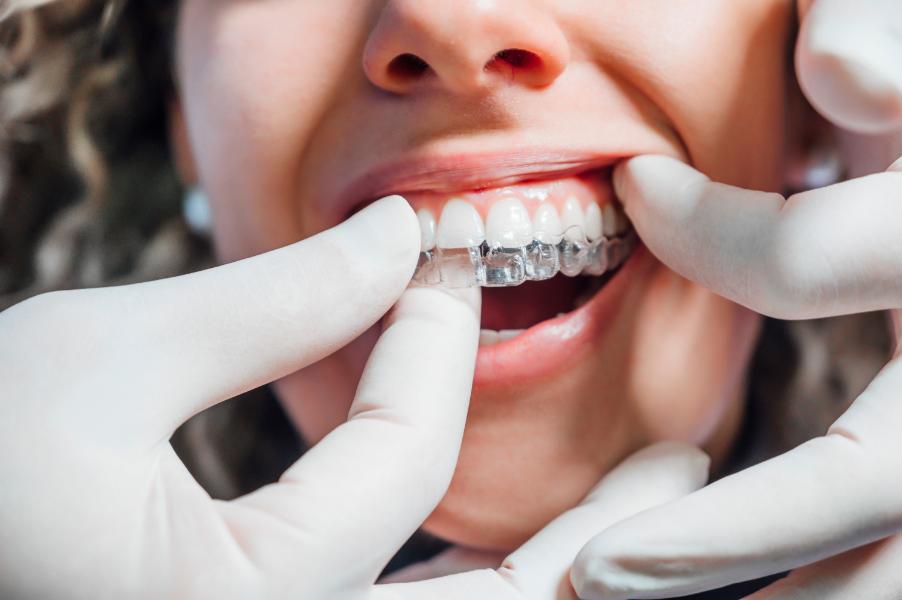Starting Invisalign? You might be asking yourself, “Is this going to hurt?” It’s a fair question—and one almost every patient has before beginning treatment.
The short answer: yes, some discomfort is normal—but it’s manageable, temporary, and often a sign that things are working exactly as they should.
Table of Contents
What Does Invisalign Pain Feel Like?
Let’s clear something up: Invisalign pain usually doesn’t feel like pain in the traditional sense. Most people describe it as a dull pressure or tenderness, especially when they switch to a new set of aligners. It’s not sharp or stabbing—more like your teeth are getting a workout.
Some notice sensitivity when eating, particularly if the aligners have been out for a bit. Others feel discomfort when putting the trays back in. Don’t worry—that soreness typically fades within a few days.
“The first few days were challenging,” one patient said. “But then it was like my teeth got used to it—and I barely noticed the pressure after that.”
Key Takeaways
-
Mild discomfort is normal—especially in the first few days with a new tray.
-
Most pain is from pressure, not sharp aches or injuries.
-
Simple remedies like cold water, chewies, or over-the-counter pain relievers can help.
-
Discomfort fades quickly—most users adjust within 2–3 days.
Understanding the Source of the Discomfort
Your Invisalign trays are constantly nudging your teeth into new positions. That slow, steady pressure is what straightens your smile—and it’s also what causes the initial discomfort.
Every time you switch to a new set of aligners, you’re starting a fresh round of movement. The first couple of days with each tray are often the most noticeable. After that? Things usually smooth out quickly.
Some patients also experience:
-
Gum or cheek irritation if aligner edges rub (easily fixed with wax).
-
Occasional headaches as teeth shift and jaw tension adjusts.
-
Isolated tooth pain—usually when a specific tooth is making a bigger move.
How Does Invisalign Pain Compare to Braces?
Think of Invisalign as the gentler cousin of traditional braces. No brackets. No poking wires. No emergency wax stash needed every time something jabs your cheek.
Braces often cause more intense pain after tightening appointments. With Invisalign, the pressure is gradual, making discomfort easier to manage. Plus, if you’re really struggling, you can briefly remove your aligners for relief—something braces won’t let you do.
Managing Invisalign Discomfort Like a Pro
1. Switch Trays Before Bed
It’s a game-changer. Most discomfort peaks in the first few hours—so switching to a new tray right before sleep lets you snooze through the worst of it.
2. Try These Quick Relief Tips
-
Cold water or compresses: These numb the area and reduce swelling.
-
Chewies: Help seat aligners and relieve pressure points.
-
Soft foods: Yogurt, oatmeal, smoothies—your teeth will appreciate the break.
-
Wax: Smooths out any annoying tray edges rubbing your gums.
-
Over-the-counter pain relievers: Ibuprofen or acetaminophen work well for the first 48 hours.
???? Pro tip: Don’t take your aligners out too often. Keeping them in helps your teeth adapt more quickly—and actually reduces discomfort in the long run.
When Should You Call Your Orthodontist?
Pain that lingers beyond four days, sharp pinching, or trays that feel too tight may need attention. Your orthodontist can adjust your treatment or provide a replacement aligner if needed.
Also reach out if:
-
A tray cracks or feels warped
-
You notice consistent bleeding gums
-
One specific tooth is throbbing or extremely sensitive for several days
Frequently Asked Questions About Invisalign Pain
How long does pain last with Invisalign?
Discomfort usually lasts 2–3 days after switching to a new aligner. For most people, it’s a cycle that repeats with each new tray but becomes milder over time as the mouth adjusts.
Which week of Invisalign hurts the most?
Week one is typically the most uncomfortable. You’re not just adjusting to pressure—you’re also getting used to wearing aligners 22+ hours a day. After that, it gets easier.
Why is my Invisalign so painful?
That pressure you’re feeling means the trays are working. But if the pain is sharp, localized, or doesn’t ease up, it’s worth getting checked. Sometimes a slight adjustment is all it takes.
How do I survive the first week of Invisalign?
Start new trays before bed. Stick to soft foods. Use chewies and cold water for relief. And most importantly, wear your aligners as directed—taking them out too much can actually make things worse.
Is the first Invisalign tray the worst?
For many patients, yes. That first tray is a big shift—your teeth, gums, and even your tongue are adjusting to something completely new. But once you’re past it, the rest usually feels more routine.
Can just one tooth hurt during treatment?
Absolutely. If a specific tooth is undergoing major movement (like rotation), you’ll likely feel it more than the others. It’s totally normal—but if it doesn’t settle down, have your provider take a look.
What can I do if it hurts to remove my aligners?
Use an aligner removal tool and take your time—start at the back molars and gently work your way forward. If it’s especially painful, take pain relief 30–60 minutes before removal.
Forums
Finding reliable advice and shared experiences from fellow Invisalign users can be incredibly beneficial in managing any discomfort you may face. Online forums are valuable platforms where you can ask questions, learn tips, and receive support from others undergoing the same treatment.
- RealSelf Dental Forum – A community where people discuss various dental treatments, including Invisalign, and share personal insights and solutions.
- Reddit’s Invisalign Subreddit – An active subreddit where users regularly post questions, experiences, and advice on dealing with Invisalign pain and other concerns.
- Metal Mouth Forum on ArchWired – Though primarily focused on braces, this forum also contains threads about Invisalign, offering helpful tips and peer support.
- MyFitnessPal Community – In the ‘Motivation and Support’ section, members discuss various health topics, including Invisalign, providing a broader community for advice and encouragement.
Final Thoughts: It Gets Better
Let’s be honest—no one loves the first few days of Invisalign. But the soreness is short-lived and, in a strange way, kind of satisfying. It means your smile is on the move.
Stick with your treatment plan, try the simple comfort tricks above, and keep your orthodontist in the loop. Before you know it, the discomfort will fade—and you’ll start seeing the results.
???? “Honestly, the first tray was the worst part. After that, I barely noticed I had them in.” —Actual Invisalign user
???? Struggling with Invisalign discomfort? You’re not alone.
At Hulse Orthodontics, we’re here to make your journey as smooth—and comfortable—as possible. For more expert advice, check out our Invisalign Tips and Tricks or What to Do if Your Invisalign Is Cutting Your Tongue.
And if you’re still weighing your options, our Veneers vs. Braces comparison might help clarify what’s right for your smile.
Need personalized advice? Book a consultation—our team is always ready to help you feel confident every step of the way.
The information in this blog is for educational purposes only and is not a substitute for professional dental or medical advice. Always consult your orthodontist if you have concerns about your treatment.

Dr. Cameron Hulse grew up in Southern Orange County, California. While in his own orthodontic treatment in high school, Dr. Hulse realized how much his new smile changed him and decided he wanted to improve other’s teeth and smiles. Dr. Hulse pursued his dream and completed a BS in Zoology at Brigham Young University. Then he was selected to attend the University of Southern California’s prestigious School of Dentistry where he received his D.D.S.. After Dental School, he switched coasts and completed his orthodontic residency at Jacksonville University where he received his CAGS.



